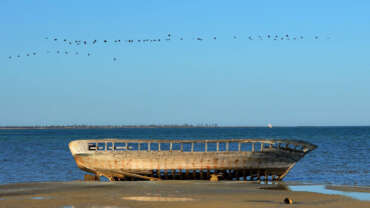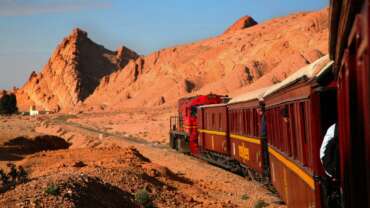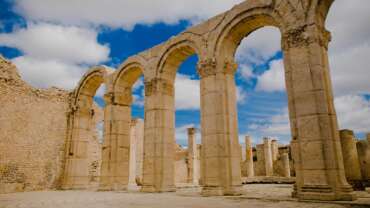Experiences in Tunisia
There’s so much to see and do in each region of Tunisia: a wide variety of landscapes, a coastline spanning 1,250km, studded with islands and archipelagos, a fantastic array of traditions and customs and a rich historical heritage. We are delighted to introduce you to these regions by breaking them down into three areas: the north, the centre and the south.
TABARKA
Visitors choose Tabarka for its exceptional location, between the sea and the mountains. The beaches of golden sand are framed by rocky spurs and forests of pine and cork oak. The crystalline waters hide the precious red coral in its depths. The characteristic silhouette of the Genoese Fort, perched upon an islet, is the emblem of Tabarka. The mountainous backcountry holds the promise of fantastic excursions and hiking around the village of Ain Draham, the entry point to a vast forested mountain range.
BIZERTE AND DOUGGA
Lovers of nature and authenticity, the beaches and valleys of northern Tunisia will take your breath away. Wild coves, forests, vineyards and vast fields of wheat… On the coast, Bizerte, sentinel of the Mediterranean, is a historic city with well-preserved charm. This lush region also is home to two locations designated UNESCO World Heritage Sites. One is a cultural site, the Roman city of Dougga, and the other, the natural reserve of Ichkeul where the lake attracts thousands of migratory birds.
NABEUL AND CAP BON
A promontory pointed towards Sicily, the Cap Bon region is a vast garden where orange and lemon trees put out their flowers in the middle of winter. Its beaches of fine sand are among the most beautiful in Tunisia. The principal town of Cap Bon, Nabeul is famous for its pottery, its rush mats and its flower essences. The fishing port of Kelibia, the thermal springs of Korbous, the falconers of El Haouaria are just a few of the curiosities found in the region.
HAMMAMET
Hectic resort in summer, well known for its beaches and its party atmosphere, Hammamet is also a small city with an authentic charm. Turquoise waters, the scent of jasmine, white houses and stone walls gilded by the centuries… its medina fringed by fine sand is particularly poetic. Nearby, the new resort town of Yasmine Hammamet offers a more contemporary setting, while the forests and lemon groves are a real pleasure for nature lovers.
TUNIS
A modern metropolis in full growth and major historic city, Tunis is always full of surprises. On the side of the medina, numerous ancient buildings open their doors, some transformed into museums or cultural centres, others into restaurants and tea rooms. Designated a UNESCO World Heritage site, the medina conceals treasures. From its gates extend picturesque quarters with beautiful façades from the 1900s, whilst on the peripheries, chic restaurants and entertainment venues rub shoulders in the modern quarters.
CARTHAGE AND SIDI BOU SAID
Close to the capital, a prestigious location and striking views: this is the introduction to the Coasts of Carthage, named after one of the most glorious ancient cities of the Mediterranean. Founded by the Phoenicians, destroyed then rebuilt by the Romans, Carthage is today a fashionable city. Next door, Sidi Bou Said is an elegant village where the blue and white houses jostle with each other on the hillside, facing the sea. Stretching out close to these inspiring locations are the beaches of Gammarth and La Marsa.
EL KEF
Leave behind Tunis and the beaches of the coast and discover a little known side of Tunisia: the Atlas Mountains and the plains of the “hauts plateaux”. In these contrasting landscapes of the west of Tunisia you’ll find Le Kef, a charming little town with a tumultuous past. Natural beauty is not the only thing this region has to offer: the town has held on to countless memories of its vibrant history, including its Ottoman fortress.
SBEITLA
Sbeitla is a small town in the central west region of Tunisia, 250km from Tunis. It is known for its remarkable Roman site and its Capitol, made up of not one but three temples, dedicated to Minerva, Jupiter and Juno, the gods who protected Rome.
SOUSSE AND PORT EL KANTAOUI
Long beaches, old stones, high palm trees… Sousse is a city ripe with seductions where entertainment and exoticism coexist harmoniously. As a major modern city, it’s one of Tunisia’s most lively coastal resorts. As a historic city, it has conserved a magnificent medina and exceptional monuments from the Middle Ages. Just a few minutes away, a tourist town with Andalusian charm has been built especially for holiday-goers, around a marina: the integrated resort of Port El Kantaoui.
MONASTIR
With its golden beaches and sapphire blue sea, its medieval monuments and its charming marina, Monastir offers one of the most attractive faces of Tunisia. An ideal destination to sun yourself by the sea, but also to visit a fascinating region: from Sousse to Kairouan, from El Jem to Mahdia, you will travel through time. In the countryside, you will get to know the way of life of the Bedouin villages. And along the coast, the fishing ports will enchant you.
KAIROUAN
Away from the coast, in a landscape of steppes, Kairouan is a fascinating city still anchored in a distant past. One of Islam’s holy cities, it was the first capital of the Maghreb. Designated a UNESCO World Heritage site, it conceals several marvels: the medina, the venerable Great Mosque, the Aghlabid Basins, the stunning mausoleum of Sidi Saheb decorated with ceramic tiles… And of course it is impossible to forget the numerous workshops where the most famous knotted pile carpets in Tunisia are made.
MAHDIA
Mahdia is small city which keeps its original traditions, where the women cover themselves with gold jewelry and the houses are decorated with embroidered hangings. Its monumental gateway calls back to its glorious past: it was the first capital of the great Fatimid dynasty, who would go on to reign in Egypt and Syria. Its medina stretches out along a narrow peninsula, surrounded by deep blue waters; its sumptuous beaches delight the tourists. A charming city with many faces.
SFAX AND KERKENNAH
A major commercial port, an old city surrounded by walls the colour of parchment, stalls echoing with the sound of artisans at work, and a cuisine built around olives, almonds and seafood… Sfax presents an original face of Tunisia, at a distance from the typical tourist itineraries. Facing it, the islands of Kerkennah offer the charm of their well-preserved landscapes and their long beaches of fine sand.
DJERBA AND ZARZIS
Both Mediterranean and Saharan at once, the island of Djerba has been a source of fascination since the time of Homer. Ulysses tasted the “lotus” there, a delicious fruit which takes away all desire to leave, and today each visitor feels spellbound by its exceptional atmosphere; an atmosphere which it shares with Zarzis, its neighbour on the mainland. But Djerba is also an island of holiday clubs, activities in the fresh air, a unique heritage to discover… and excursions into the majestic setting of the Sahara.
TOZEUR AND NEFTA
Towns arising from the desert and pressed against vast palm groves, Tozeur and Nefta surprise, fascinate and immerse visitors in a surreal landscape. The burning light of the Sahara pours into narrow streets of the old quarters, between the high façades and golden coloured bricks. In Tozeur, palaces, theme parks and museums have flourished around the old town. In Nefta, countless domes indicate the tombs of saints, overlooking the oasis which nestles in a basin called the Basket. The dunes of the Sahara are just a few kilometres away…
DOUZ
Covered by a fine white mantle reminiscent of a snow-covered landscape, the Douz region offers one of the gentlest ways to approach the desert. Cordons of dunes and graceful bouquets of palm trees fringe the roads the sand slowly reclaims. The golden vastness of the desert is here, at hand, while the palm groves offer delectable shady places to stop in the forests of date palms. In the heart of the region, a vast salty expanse with shimmering reflections: the Chott El-Jerid.
TATAOUINE
Around Tataouine and Medenine, the desert appears in all its implacable ruggedness. A vast rocky plain opens onto majestic landscapes of mountains and desert plateaus, cliffs and rocky spurs. In this Dante-esque setting can be found the astonishing architecture of the Ksour, collective fortified granaries of the Saharan nomads. Just as impressive are the old Berber villages clinging to the mountain tops, such as Chenini and Douiret. A region of out of the ordinary landscapes and historical traditions.
GABES AND MATMATA
Gabes is the only coastal oasis in the Mediterranean, surrounded by fine sand beaches. Its vast palm grove is truly enchanting, and its old city is distinguished by its authentic atmosphere. But Gabes is above all the entrance to the Sahara; the start of a journey between ridges and arid hills, Bedouin tents and old Berber villages. Here you’ll find still-living traditions and an ancestral way of life, such as the stunning underground village of mount Matmata.










